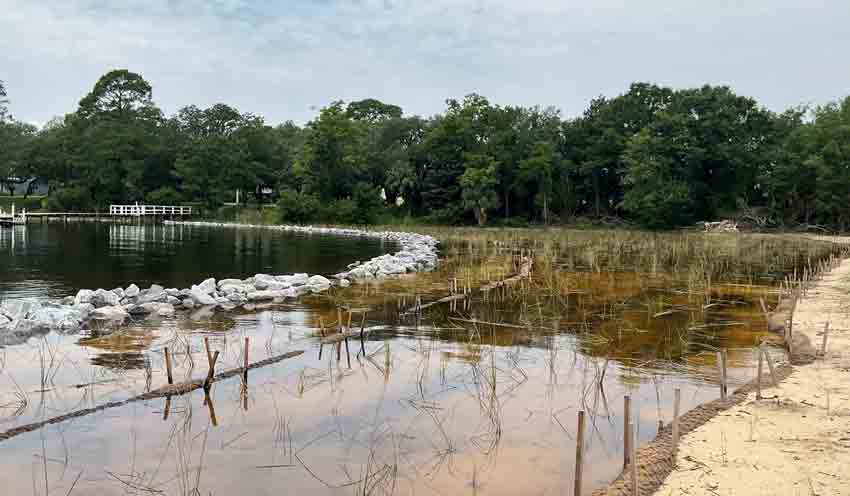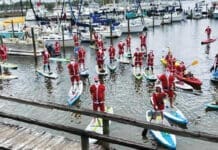Through the support of a BP oil spill-related grant issued by the National Fish and Wildlife Foundation, the City of Niceville initiated the Boggy Bayou Headwaters Restoration project to address water quality concerns and habitat conditions near the Turkey Creek outfall. The project is permitted through the Florida Department of Environmental Protection and the U.S. Army Corps of Engineers. Construction began in February and is substantially complete.
 The improvements included the formation of a new western marsh peninsula and the installation of an eastern oyster shell eastern breakwaters near the neighboring marina to protect the vegetative communities in the headwaters and to direct any creek sediments into the middle of the bayou. The accretion of sediment has historically shallowed the waterfront, making the Valparaiso boat ramp unusable.
The improvements included the formation of a new western marsh peninsula and the installation of an eastern oyster shell eastern breakwaters near the neighboring marina to protect the vegetative communities in the headwaters and to direct any creek sediments into the middle of the bayou. The accretion of sediment has historically shallowed the waterfront, making the Valparaiso boat ramp unusable.
Although upstream sediment controls have significantly reduced this accretion over the past two decades, accumulated sediment, debris, and vegetation was removed near the S.R. 20 bridge to divert flows and slow the water discharging into the bayou. Additional flow paths have been opened to the east and west to diversify and slow the flows, allowing sediment and nutrients adversely affecting water quality to be absorbed by the marsh vegetation within the headwaters. These flow diversion efforts will also improve dissolved oxygen levels throughout the headwaters, enhancing natural habitat that will substantially improve water quality in previously stagnant areas.
A two-year program to eradicate exotic and nuisance species removal throughout this region continues and will be significantly enhanced through “living shorelines.” These include the planting of native species along the shorelines and newly constructed marsh areas to suppress the re-emergence of exotic vegetation and to improve the public viewshed of this scenic landscape.
Following native plantings on the newly formed western peninsula and along the Kiwanis Park shoreline, construction will be complete. Coconut-fiber coir logs have been installed to protect the plantings and these coir logs will naturally dissolve over time. Public awareness is vital to ensuring the preservation of these improvements until the system has a chance to stabilize. A subsequent monitoring program is scheduled for a five-year period to monitor the conditions and to ensure the ecological systems can stabilize and perform as designed.
Two osprey platforms were also installed at the terminus of each peninsula extending into Boggy Bayou. Since the completion of the improvements, residents, commercial operators, kayakers, and others based or visiting the area have shared observations of teeming wildlife. Local resident Debra Wolfenden frequently kayaks in the headwaters and offered, “I have never seen so many ospreys, bald eagles, terns, blue herons and seagulls all in one place.” An increase in redfish and smaller juvenile fish has been observed by neighboring businesses and residents. Wolfenden added, “I love that grasses were planted to attract the fingerlings, this will be an awesome estuary for them. I am so excited that some positive work is being done to save our beautiful Boggy Bayou and its health. This is why we live in and love this area so much—we have a City that cares about the future of our environment for generations to come.”
The headwaters area of Boggy Bayou is a unique ecological system and, once established, the improved wildlife habitat and water quality along with enhanced scenery will serve as a long-term environmental jewel for all residents and visitors of Niceville to enjoy.






























































